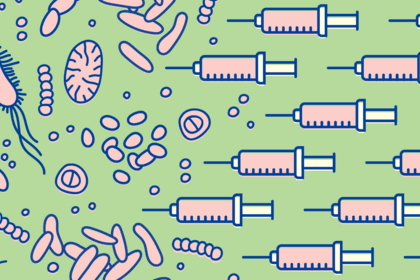
Why data is key to tackling antimicrobial resistance
Antimicrobial resistance disproportionately affects people living in low- and middle-income countries. Data is key to tracking and addressing this threat, says Dr Andrew Kambugu, but data collection has challenges.

Wellcome
The picture of antimicrobial resistance is evolving – it’s like a moving target. If you can’t observe that target moving, you can’t hit it. That’s why data is so important.
The problem is that we have critical data gaps in low- and middle-income countries, even though the rate of deaths associated with antimicrobial resistance is almost twice as high in some of these countries compared to high-income countries like the UK.
But we shouldn’t throw our hands up in the air and despair. Let’s get in the trenches and start collecting the data.
Why is data so important?
As a clinician, data informs how you approach an individual patient or group of patients in a particular location.
Data also enables us to track the evolving picture of antimicrobial resistance. Surveillance and monitoring programmes need to continually sample the data so they can appreciate the changes in the resistance profile of different pathogens.
For us in low- and middle-income countries specifically, we also really need to think about the judicious use of resources. Data helps us to allocate resources where they’re needed most.
But in these countries, we struggle to get accurate data around antimicrobial resistance.
Low- and middle-income countries have critical data gaps
Resources are limited and healthcare systems are typically underfunded. We may not have the right infrastructure to collect the data, but we also may not have the right diagnostics.
If someone walks into the clinic, are we able to accurately identify that they have an infection, and whether it’s resistant to antimicrobials?
Another data challenge is the regulatory framework and the ability to enforce existing policies. In Uganda, you can walk into a pharmacy and get an antibiotic, sometimes without a prescription. This means we can’t always document who is using the antibiotics.
A data-centred approach to tackling antimicrobial resistance
I’m the Uganda hub lead for CAMO-Net, the Centre for Antimicrobial Optimisation. CAMO-Net brings together hubs in five countries – Uganda, South Africa, India, Brazil and the UK. This global network is populating the global data resource for antimicrobial resistance. Each hub contributes data for its own region, which is important as the drivers of antimicrobial resistance differ in each region.
Anyone across the network can interrogate the data, undertake analysis, gain insights, and then test those insights back in our communities. It’s very exciting to have this data-centred approach.
We’re also engaging lawmakers to understand this looming threat of antimicrobial resistance, so that appropriate and adequate national resources can be allocated to mitigate it.
We’re engaging with patient groups, too, as they’re the ones who consume the antibiotics. Our peer educators go out into the community and use music, dance and drama to communicate that an antibiotic is a precious thing that should be preserved for when it is really needed. It’s quite amazing to see how effectively they’re able to communicate compared to what I’d be able to do as a doctor.

The CAMO-Net Uganda hub team engages community members through music, dance and acting. These creative approaches are used to raise awareness about antimicrobial resistance (AMR) and promote responsible antimicrobial use at the grassroots level.
Infectious Diseases Institute (IDI)
We still need more investment in new antibiotics
Antibiotics are one of the interventions that have been most impactful in modern medicine. But there are not enough new antibiotics in the pipeline. In high-income countries, which still have most of the resources for research and development, infections are less of a threat than non-communicable diseases.
We need to keep investing in the production of new antibiotics.
We’re living in the age of travel. Covid-19 showed us how quickly an infectious disease can spread all over the world. An antimicrobial resistance threat in Uganda is an antimicrobial resistance threat anywhere.
Data is vital for this research and innovation. Looking at the data enables you to pose the right research questions and generate the right answers. As well as identifying why resistance is increasing, we can look for new antibiotics, new solutions, and new approaches.
This article was first published in 'Behind the Research', our LinkedIn newsletter sharing insights and stories from experts in global health research.




